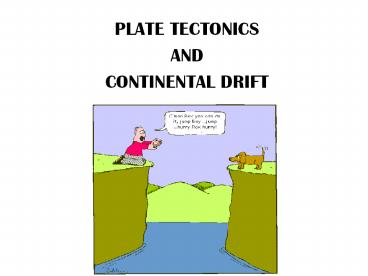PLATE TECTONICS PowerPoint PPT Presentation
Title: PLATE TECTONICS
1
- PLATE TECTONICS
- AND
- CONTINENTAL DRIFT
2
GEOLOGY
- Geology is the science and study of the solid
Earth and the processes by which it is shaped and
changed. - Geologists are scientists who study the forces
that make and shape the planet Earth.
3
Theory of continental drift
- Alfred Wegener first proposed the theory of
continental drift in 1912. - Continental drift is Wegeners theory that all
continents had once been joined together in a
single landmass and have drifted apart since. - Wegener named this supercontinent Pangaea.
- Wegeners theory was rejected by scientists
because he could not explain what force pushes
or pulls continents.
4
PANGEA
5
(No Transcript)
6
Evidence to support continental drift theory
- Sequence of Rocks
- Same rock patterns found in South America, India,
Africa, Antarctica and Australia
- Ancient Climates
- Tropical plant remains found in Antarctica
- Glaciations in Africa, South America, India, and
Australia during the same time
7
Evidence to support continental drift theory
- Distribution of Fossils
- Plant and animal fossils found on the coastlines
of different continents
- Puzzle Pieces
- Continents look like they could be part of a
giant jigsaw puzzle
8
Sea-Floor Spreading
- In the early 1960s, Princeton geologist Harry
Hess proposed the hypothesis of sea-floor
spreading, in which magma from the mantle rises
to create new ocean floor at mid-ocean ridges. - The mid-ocean ridge is the longest chain of
mountains found deep below the oceans surface .
9
(No Transcript)
10
SUBDUCTION
- The ocean floor plunges into deep underwater
canyons called deep-ocean trenches. - Subduction takes place in deep-ocean trenches.
- Subduction is the process by which the ocean
floor sinks beneath a deep-ocean trench and back
into the mantle.
11
PLATE TECTONICS
- The Earths crust is divided into 12-13 major
plates which are moved in various directions.
12
Plate Movement
- Plates of lithosphere are moved around by the
underlying hot mantle convection cells
13
3 types of plate boundaries
- Divergent
- Convergent
- Transform
14
DIVERGENT BOUNDARY
- At divergent boundaries, two plates move apart
from each other and the space that this creates
is filled with new crustal material sourced from
molten magma that forms below.
15
CONVERGENT BOUNDARY
- A tectonic boundary where two plates are moving
toward each other. If the two plates are of equal
density, they usually push up against each other,
forming a mountain chain. If they are of unequal
density, one plate usually sinks beneath the
other in a subduction zone.
16
There are 3 types of convergent plate boundaries
- Continent Continent When two continents meet
head-on, neither is subducted because the
continental rocks are relatively light. (forms
mountains) - Ocean Continent When an oceanic plate pushes
into and subducts under a continental plate (
creates volcanoes) - Ocean Ocean When two oceanic plates converge
one is usually subducted under the other. (forms
trenches)
17
Oceanic-continental
- Continental-continental
- Oceanic-oceanic
18
TRANSFORM FAULT BOUNDARY
- Transform Plate Boundaries are locations where
two plates slide past one another. The fracture
zone that forms a transform plate boundary is
known as a transform fault.
19
(No Transcript)

